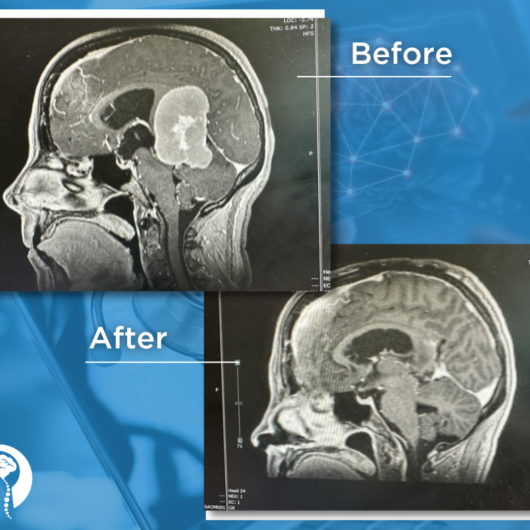When Ginger Miller started experiencing visual flashes and acute headaches in 2021, she jumped on the internet and diagnosed herself with retinal migraines. The true cause of her symptoms, however, was much more serious.
Miller, now 60 of Aurora, Colo., had a brain tumor the size of a baseball buried deep within her brain, nestled amongst the veins around the brainstem that drain blood from the brain.
“Our concern over tumor removal was the possible changes in venous blood flow around the brain that might cause strokes that would leave her paralyzed, in a coma, or ‘locked in.’” said Dr John Hudson, MD, PhD, FAANS, a cerebrovascular and tumor neurosurgeon with Neurosurgery One in Denver in Lakewood, Colo.
Miller started experiencing the flashes and intense headaches sporadically at first. As they became more frequent, she started becoming dizzy as well. Once the headaches and dizziness started happening multiple times a day, she quit her job. Initially she was diagnosed as having vertigo but a follow-up MRI revealed the tumor, a typically non-cancerous type of tumor called a meningioma.

Meningiomas are named this because they form in the meninges, which are the layers of tissue that cover the brain and spinal cord. The coverings of the brain extend between the two sides, or hemispheres, of the brain as well as above and below the cerebellum (a portion of the brain that sits at the base of the cerebrum and controls motor coordination, posture, and balance). They also can arise from meningothelial cells in the choroid plexus, which is the material inside the ventricles that produces cerebrospinal fluid.
“When I walked into my doctor’s office to get the results, you could tell by the look on everyone’s faces that it wasn’t good,” Miller said.
Miller’s primary care provider gave her a list of neurosurgeons and after doing more online research, she chose Neurosurgery One where she was referred to Dr. Hudson.
“I adore Dr. Hudson; he saved my life,” Miller said. “He is my hero. He spent an hour and a half with me and my husband at the first appointment. We never felt rushed, and he answered every question. Then (Dr. Hudson’s physician assistant) Anna Jackson was absolutely fantastic. I would call her I don’t know how many different times asking her questions and she would ease my mind. When I left Dr. Hudson office, I knew he was the one I wanted to do my brain surgery.”
Miller’s surgery was performed Dec. 7, 2021, at St. Anthony Medical Center. It lasted more than 10 hours and recovery was touch-and-go, her husband, Barry, said. “It took over six hours until she woke up from the anesthesia.”

Following her initial recovery, Miller stayed in the ICU for 18 days and another three weeks in rehabilitation. Now 18 months after her surgery, Miller says that while she still struggles a bit with balance, she is doing great.
“I didn’t expect to be doing so well,” she said. “Dr. Hudson made no bones about the potential of what could happen after surgery. He told us everything. We were prepared for me to come out in a wheelchair and maybe paralyzed. That’s another reason he’s my hero is because he was so honest.”
Feeling like she’s “mostly normal,” Miller is now looking forward to finally trying out her new kayak at their vacation home in Lake Havasu City, Ariz.



